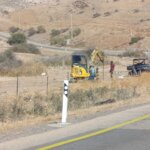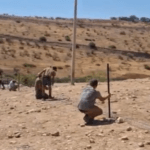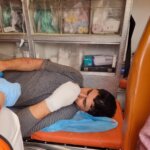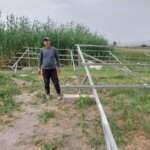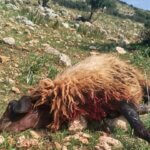The “Eastern Border”: Palestinians of The Jordan Valley
Sunday, 15 February 2009
By Fathy Khdirat, Coordinator of the Jordan Valley Solidarity Campaign
REPORT: Civil Resistance to Systematic Displacement
Content:
1) The Jordan Valley
2) The 1967 Occupation and Subsequent Displacement Policies
3) The Allon Plan (1967-1970)
4) Segregation: The Wall and its Associated Regime in the Jordan Valley
5) The Campaign to Boycott Carmel-Agrexco
6) The Jordan Valley: Daily Life Under a Colonial-Apartheid Occupation
7) Electricity – Water
8) Labor and Livelihood
9) The Jordan Valley Solidarity Campaign
The 2400 km² plain occupied by Israel in 1967 is home to approximately 56,000 Palestinians living in 24 population centers in addition to several Bedouin and pastoral nomadic communities. Around 70% of this population lives in Jericho with the remaining population mainly concentrated in the central part of the Valley, which includes the towns of Jiftlik, Marj Na’jah, Zubeidat, al-Nassariyah, Beit Hassan and others. The main villages of the northern part of the Valley are Bardala, Ein al-Baida, and al-Malih. The primary source of livelihood for the Palestinians of the Jordan Valley is crop and livestock farming, followed by commerce and tourism, and finally some work as day-laborers in Israeli settlements.
The 1967 Occupation and Subsequent Displacement Policies
The Israeli military expelled most residents of the Jordan Valley during the 1967 war, most of whom became refugees in Jordan. Approximately 10,000 Palestinians remained in the Jordan Valley, including Jericho, after the war. It was not until later that Palestinian activists discovered that the Jordan Valley, together with Jerusalem, were singled out for complete Israeli control under the recommendations of the Allon Plan, and subsequent Israeli plans for control of the West Bank. Soon after the occupation, the Israeli occupation authorities began the implementation of policies aimed at displacing the remaining Palestinian population.
The Allon Plan (1967-1970)
After the June 1967 war, Israel’s military leadership sought ways of dealing with the newly occupied West Bank and Gaza Strip. Barely six weeks after the occupation, then Labor Minister Yigal Allon presented his proposal to the Knesset, a plan which since then has operated as the basis for Israel’s military administration of the West Bank. The main tenets of the Allon Plan are the division of the West Bank into two parts (north and south) by the complete annexation of Jerusalem and extending the Jerusalem corridor to the Jordan Valley. This area is also completely separated from Jordan by the annexation of the Jordan Valley. In the initial Allon Plan, refugees in Gaza (three-quarters of the population) were to be transferred to the two West Bank reserves, and the Gaza Strip was to be annexed to Israel through colonial settlement. Since 1967, the Allon Plan has been revised and developed in numerous ways. In 1976, under Yitzhak Rabin’s leadership, the Israeli government began expanding settlement areas deep into the West Bank, a process that was accelerated after the 1977 Likud victory which brought in Ariel Sharon as the Chairman of the Inter-Ministerial Settlement Committee and who put in place plans for massive settlement expansion in the West Bank.
Within the first six months of the occupation, and armed with detailed maps and reports about the area, Israeli settlers set up the first illegal colonies in the Jordan Valley. Following this, the Israeli military set up a security border zone, 1-3km in width along the Jordan River, from the Dead Sea in the south to the “green line” in the north. Palestinians were barred from entering this area, which meant that thousands of families who depended on farming for their livelihood could not access their lands along the river. The farming equipment of many of these families still sits rusting along the western bank of the river as a testament to the rightful owners and tillers of the land.
Among these displacement policies and practices was a daily curfew that often lasted several days at a time; our elders say they sometimes forgot what day it was as a result of being imprisoned within their own homes. Curfew was always accompanied by a shortage of food and essential services, and anyone caught outside of their homes before 6 am or after 6 pm would be shot on the spot; hundreds of Palestinians were killed or injured in this way, especially during the first year of the occupation. The Israeli military also targeted Palestinian shepherd’s livestock, and tens of thousands of sheep and goats were killed in the Jordan Valley particularly in the first two years of the occupation.
Soon after the 1967 occupation, the Israeli authorities undertook a census of Palestinians in the Valley who were issued ID cards stating their place of residence as the Jordan Valley. Palestinians with addresses other than the Jordan Valley were not allowed to enter the area with the exception of Jericho, a segregation practice that continues until today, albeit more effectively given Israel’s Wall and its associated regime. In the first years after 1967, the Israeli occupation authorities issued tens of confiscation orders that resulted in the removal of Palestinians from hundreds of thousands of dunums under the pretext of Israeli security needs. Confiscation was undertaken under numerous pretexts, including military necessity, which transformed the land into military training areas and military bases, as well as more seemingly benign purposes such as the creation of closed ecological and natural reserves. Eight percent of the Jordan Valley was expropriated as absentee property, land which rightfully belongs to Palestinian refugees expelled during the 1967 war.
Segregation: The Wall and its Associated Regime in the Jordan Valley
While the first civilian settlements were set up in the early days of 1968, it was with the onset of the 1980s, and especially as the world focused on the Israeli invasion and occupation of Lebanon, that the Israeli government began an intensive campaign of settlement construction and expansion in the Jordan Valley. Much of the land that had previously been confiscated under a security pretext, becoming closed military areas or even military bases, was transformed into settlement colonies for Jewish-Israelis, completely integrated into the Israeli water and electricity grids. These “Jewish-only” areas were then expanded and other plots of land confiscated for new settlements.
Throughout the 1980s, the Israeli government implemented policies to encourage Jewish-Israeli civilians to move into the illegal settlements, including subsidizing the cost of utilities and housing. After the Oslo agreements of the mid-1990s, Israeli settlements greatly expanded, increasing in size and number. The “development” of the agricultural production in these settlements during this period involved pumping millions of dollars into “strategic crops” like palm trees to bolster Israel’s competitiveness as an exporter of these crops despite the formal reticence of most of the international community to import settlement products.
The Campaign to Boycott Carmel-Agrexco
One of the Israeli companies directly profiting from the occupation is Carmel-Agrexco. Carmel-Agrexco is 50% owned by the Israeli government and imports produce from Occupation settlements in the West Bank. Agrexco is a partnership between Gol (50%), Israeli growers (25%) and the Tnuva cooperative (25%). Agrexco is the largest exporter of settlement produce, primarily selling produce from settlements in the Jordan Valley. The company is responsible for 70% of Israeli fresh produce sold abroad, with annual sales amounting to $750 million in 2006 (80% from exports). In the UK Agrexco is known under the Carmel, Coral and Jaffa brands.
While Agrexco and the occupation profit, Palestinian farmers continue to suffer as Israel insists on blocking Palestinian exports. Additionally, occupation forces continue to steal crucial land and water resources. These factors, along with the Wall, settlers’ roads and military checkpoints have devastated Palestinian agriculture and forced many Palestinians to seek jobs inside Israel, where they suffer from low wages and a lack of workers’ rights. Boycott, Divestment and Sanctions (BDS) Campaign activists in the UK (largest importer of Israeli agricultural exports) and Belgium have launched campaigns to boycott Carmel-Agrexco until Israel complies with international law. (More on the BDS campaign at www.bdsmovement.net ).
A further increase in the number of Jewish-Israeli settlers in the Jordan Valley came with the 2005 Israeli “disengagement” from Gaza in which a number of Gaza settlers were relocated to the Valley. Today, there are approximately 9,000 settlers living in 36 Jewish-only settlements in the Jordan Valley directly controlling 1200 km² of the most fertile and resource-rich land in this important area. It is also important to note that eight of these illegal settlements are home to no more than twenty or so Jewish-Israelis; an indication that the occupation authorities have no qualms confiscating the land of tens of Palestinian families and depriving them of essential services just to settle one or two Jewish families on large farming estates with all the luxuries and amenities of life provided courtesy of the Israeli regime.
The fact that a portion of the land of the Jordan Valley is still inhabited by Palestinians does not mean that Palestinians exercise any control over this territory. The city of Jericho, supposedly under full Palestinian Authority control (Area A) according to the Oslo agreements, was victim to military assault several times during the Second Intifada. These assaults involved the demolition of Palestinian homes and the destruction of roads, water pipes, and other important infrastructure. Israeli military jeeps are regularly seen patrolling the outskirts of the city, which has been locked in an Israeli stranglehold for since 2000. The two roads leading in and out of the city are completely controlled by Israeli military checkpoints, and the military has dug a trench around the rest of the city to prevent the city from geographically expanding. Furthermore, no major Palestinian construction projects, including irrigation and drinking water networks, water storage facilities, and sewage networks, can be carried out without the approval of the Israeli military authorities.
Al-‘Auja is the other “Area A” community, but is a prototype of a Palestinian village subjected to daily military and settler harassment, military-imposed curfews, prevention of access to essential services, colonial settlement expansion, as well as home and workplace demolition.
The situation is much worse in the five Palestinian population centers classified as “Area B” (Palestinian civil control, Israeli security control) under the Oslo arrangements. The Palestinian Authority is responsible for issuing building permits, and as such Palestinians are allowed to build in these towns and villages. The Israeli occupation authorities, however, have banned any expansion of the boundaries of these localities, the area on which Palestinians are allowed to build, since the 1967 occupation. The result is that these five towns and villages have some of the highest population density in Palestine. The problem of high population density is intensified by the fact that Palestinians displaced from the rest of the Jordan Valley as a result of Israeli policies and practices (twenty or so communities classified as Area C – complete Israeli control) seek refuge in these “Area B” towns and villages. The Israeli authorities have sealed off the “Area B” population centers segregating them from the rest of Palestine by banning anyone who is not resident there, including Israeli citizens, from entering without Israeli military permission. In short, each of these places is an overcrowded open-air prison.
The Jordan Valley: Daily Life Under a Colonial-Apartheid Occupation
The clear strategic goal of the Israeli establishment in the Jordan Valley has been to maintain complete control over the Valley. In an televised interview in which he set out the bare minimum that Israel would accept in the negotiation process, former Israeli Prime Minister Ehud Olmert stated that “[i]t is impossible to abandon control of the eastern border [the Jordan Valley] of Israel.”1 This goal has involved the concentration of the Palestinians in the Jordan Valley mainly in Jericho and Al-‘Auja (“Area A”), and in the “Area B” towns and villages – i.e., displacing them from the rest of the Valley – while also making life in these Area A and B population centers very difficult as a disincentive for people to stay.
In addition to the overt military and settler policies and practices such as segregation and violence leading to forced displacement, the occupation authorities have systematically assaulted the Palestinians of the Jordan Valley at the level of daily life. This assault has been concentrated on our essential needs such as electricity, water, housing, work, and, as described above, mobility.
Electricity
The vast majority of Palestinians in the Jordan Valley suffer shortages of electricity, albeit with varying intensity. Al-‘Auja, Jericho and the surrounding refugee camps (Ein Sultan and Aqabet Jaber) received their electricity from the Jerusalem Electricity Company, but brown-outs and blackouts were common, and more recently these areas have been connected with the Jordanian electricity grid. Approximately fifteen percent of Palestinians in the northern Jordan Valley receive electricity through the Israeli electricity grid. The remainder of the Palestinians in the Jordan Valley (Area C) rely completely on power generators for which they purchase fuel. This is in sharp contrast to the subsidized electricity of the Israeli settlers in the illegal Jordan Valley settlements.
Water
Within the first months of the occupation, the Israeli military took control of all major water resources in the Jordan Valley, which came under the control of the Israeli Water Authority. The means of Israeli control over water varied from limiting the amount of water Palestinian farmers could draw from their wells, to banning the digging of new wells and renovation of existing wells, to outright seizure of the land in which water springs or wells existed. The Water Authority handed these water resources to Mekorot, Israel’s national water corporation, which immediately set out to dig hundreds of wells to service the illegal Israeli settlements of the Valley. Palestinians were, and continue to be, banned from digging wells beyond 200 m in depth, a restriction that has never applied to Israeli settlements let alone Mekorot. As a direct result, the vast majority of Palestinian water wells and the springs to which Palestinians have access are salinated, polluted or have completely dried up. Today, Palestinians in the Jordan Valley have little or no access to drinking water, let alone water for use in agriculture or industry.
The Israeli policy of limiting and eliminating Palestinian access to water, combined with the resulting sharp increase in the price of water resulting from Israeli policies, has been one of the main reasons for displacement of Palestinians in the Jordan Valley since 1967. Palestinians are still banned from building any water-related infrastructure connecting Area C communities to the water grid in Areas A and B in the Jordan Valley, and attempts at expanding the water networks of A and B areas have resulted in swift Israeli demolition of the pipes and pumps. Palestinians who have remained steadfast on their land outside of Areas A and B are forced to purchase their water by the tank at the cost of 33 Israeli Shekels (approximately US $9) per cubic meter; often the only vendors are the nearby illegal Israeli settlers! The result is that Palestinian families in “Area C” communities in the Jordan Valley pay anywhere from 30-80 percent of their gross monthly income on water.
A very clear example of the workings of Israeli policy regarding water in the Jordan Valley over the past year have been the villages of Humsa and al-Hadidiya, both of which attempted to establish water reservoirs and a water network, both of which faced a brutal Israeli response involving the confiscation of all the equipment used in creating these reservoirs, including the water tanks and trucks, and both of which experienced the displacement of approximately half of their residents as a result.
The discriminatory aspect of the occupation’s water policy in the Jordan Valley is very clear when we compare the Palestinian access to water with that of the Israeli settlers. Palestinians in communities connected to the Mekorot water grid are charged higher prices for water in comparison to settlers who receive subsidies on water that is for domestic use. This water discount for settlers can reach up to seventy-five percent. Settlement municipal councils cover the water expenses for the lush parks, swimming pools and other public services in the illegal settlements. Settlers have access to “unlimited” water, with irrigation water provided almost for free – they pay the “pumping fees.”
Labor and Livelihood
Considering that the vast majority of Palestinian communities in the Jordan Valley, with the exception of Jericho, are agricultural and pastoral communities, and that most of their land and access to water has been severed by Israel, these Palestinian communities face a crisis in both their way of life and their livelihood. Unemployment rates in the Jordan Valley are among the highest in Palestine, and the only real employment opportunities exist in the form of cheap exploitable labor in the settlements, since there are little to no institutions that have offices in the Jordan Valley and employ people from the local communities. It is important to note that even employers in the settlements looking for exploitable workers generally prefer not to employ Palestinians from the Jordan Valley, and as such the proportion of people who find work in the settlements is not more than three percent of the Jordan Valley population. The poor level of education, access to electricity, computers, the Internet, and communications networks also plays a role in limiting potential employment opportunities of Palestinians in the Jordan Valley.
The Jordan Valley Solidarity Campaign
In 2003, several community members in the Jordan Valley came together to try to build a community-based campaign to defend the indigenous community’s presence. Five years later, the campaign continues to grow, and has spread to all of the Palestinian communities in the Valley. The Capacities of the Campaign are still quite limited, since it is based on community members volunteering their time and energy, with no budget to speak of or any sources of funding except in the rare cases that a person or an institution comes forward who is willing to fund a project that the campaign has undertaken. Since its inception, the campaign has been open to working with any individual or organization that shares its political analysis of the problem facing the Palestinians of the Jordan Valley and shares the commitment to maintain and strengthen Palestinian presence in the Valley.
The Campaign’s activities center around non-violent actions, which strengthen the steadfastness of Palestinians in the Valley. This has ranged from raising funds to deliver water to those most in need of it, to mobilizing local communities around rebuilding structures destroyed by the Israeli occupation. One of our current campaigns involves mobilizing and educating Jordan Valley communities about the traditional methods of building using homemade hay-and-clay bricks. In the past two-years we have also built a school in the village of Fasayel.
The second major task of the campaign is raising awareness about the plight of Palestinians in the Jordan Valley and the urgency of supporting them both at the national and international level. This is particularly important given that it is a topic most often ignored in discussions about Palestine and the occupation. This advocacy work is carried out through preparing written, audio, and visual materials that advocates of Palestinian rights can use, trying to attract media attention to the situation in the Jordan Valley, offering eyewitness tours for visitors to Palestine so they can see for themselves what is described above. A part of this advocacy work is also trying to get international agencies operating in the region, and often pressuring them to operate in the Jordan Valley, to provide the services most needed by the local community, and to monitor the effects of the Israeli policies and practices on the people and the land.
The Campaign continues to face several challenges. One of the first obstacles to mobilizing the local community is the large distance between the communities of the 150 km long Jordan Valley. There is no cost-effective means of public transportation available to Palestinians in the Valley, which includes the Campaign organizers. While dealing directly and in-person with community members is the ideal means of communication, the use of phones and other communication technology is also very expensive, since there is no Palestinian communication infrastructure outside of the Area A and B towns and villages, and the Israeli alternative is costly. The Internet is completely useless as a means of communication within the Valley given that only an extremely tiny minority has Internet access. The dearth of sources of funding that would allow for the Campaign to sustain itself as an independent grassroots initiative is a further major challenge.
Despite these challenges the Campaign continues based on the determination of the people of the Jordan Valley to remain steadfast on their land, and in the ongoing struggle to regain the land and resources taken from them, the Palestinians of the Jordan Valley.
* Fathy Khdirat is the Coordinator of the Jordan Valley Solidarity Campaign. This article was translated from Arabic by Hazem Jamjoum, and appeared in the Autumn 2008 / Winter 2009 Double Issue of al-Majdal, the quarterly magazine of the Badil Resource Center for Palestinian Residency and Refugee Rights. http://www.badil.org/al-majdal/al-majdal.htm

